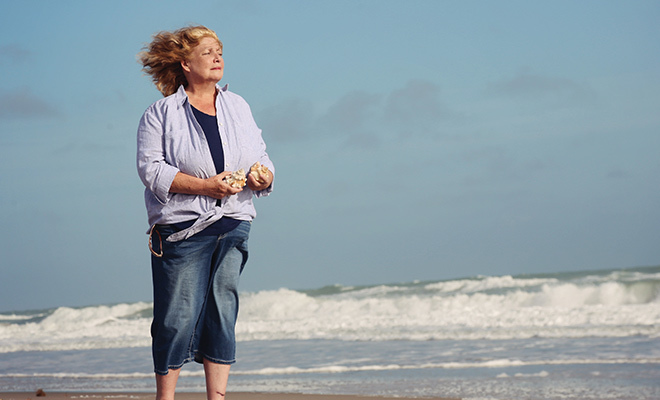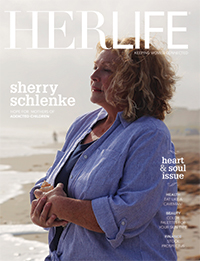
Sherry Schlenke: Healing Through Helping Other Moms
Do you know that feeling when you’re lying under a tree, staring up into the branches and hearing no sound but the breeze blowing the leaves and limbs? You can feel the strength of the branches exuding from the sturdy trunk below.
As parents, we often feel like that sturdy trunk, strongly rooted, supporting many blowing limbs, and it’s difficult to understand how providing a nurturing, loving, careful childhood could lead your son to embark on a 20-year struggle with drug addiction.
Sherry Schlenke’s story is one of pain, disbelief, anguish, sadness, disappointment, resilience and survival. Her husband and daughter understand, now, how that branch can break, because it happened to them, but that is no answer for the why. Why did their son, who was born to educated parents who wanted him and doted on him, become addicted to heroin?
He was their blonde, blue-eyed, handsome, friendly, charismatic, inquisitive, reliable child. He had a younger sister who adored him. His father worked hard so the children could attend good schools, and Sherry taught at their school so she could be off when they were out of school.
Over a span of 20 agonizing years, their son went from smoking pot at 15 to trying every drug offered or available to him, prison, and, finally, a tragic ending. His drug of choice was heroin. This artistic, talented young man began to spiral; his grades began to drop and he barely graduated from high school. Sherry and her husband, in an effort to help him, called upon the best drug addiction counselors and physicians. All the while, Sherry was trying to still show the world a healthy family, although strange people began to frequent their home and she began to fear for the safety of her younger daughter.
“When my son died after a nearly 20-year struggle with drug addiction, my memories of him and the difficult choices that I made both with and for my family were foremost in my thoughts every minute of every day,” Sherry explained. “I had become an expert at compartmentalizing my life in order to be productive at work and to maintain a facade for the outside world. However, I was in emotional agony. Not only had my son died due to his deadly choices, but I had walked away from him when I realized that I could not save him from drugs. The guilt that I felt was all-consuming.”
Because her family had been to therapy for decades, she felt she would not benefit from it anymore. Then, two months after her beloved son died, she found The Addict’s Mom (TAM) website online, a forum founded by Barbara Theodosiou as a place where mothers can share without shame.
“As I read the posts from other mothers, I felt the support and understanding, and I was amazed to learn that many families were battling the dreadful monster of addiction. Many moms had endured unimaginable tragedies with their children: assault, murder, incarceration for life, overdose and psychiatric interventions,” Sherry revealed. “Moms are raising grandchildren; moms are poverty-stricken, senior citizens and ill. They are desperate.”
Through reading the posts, she slowly began to heal. After keeping her secret private from everyone, including friends, family and co-workers, for almost 20 years, TAM was a miracle for Sherry. “On TAM, I shared my tragedy, and I discovered that thousands of moms all over the world had not only experienced the same horrible events with their child, but they had also experienced feelings of guilt and shame,” she noted. “The moms of TAM taught me how to recover myself, my soul and my sanity. Now I volunteer for TAM; I am giving of myself to help others in the same devastating situation with a child. By helping them, I am healing.”
Sherry, her son-in-law and daughter and her husband now live in Jensen Beach. They re-invented themselves when they were forced to move away from the son they loved. She began a new career, her husband retired, and their daughter went to university.
“I have a master of education degree in special education. For decades, I have worked with at-risk children, teaching them the necessary academic and coping skills in order to increase their chances for a positive life outcome,” she mused. “Ironically, I could not save my own boy. I also stay busy reading, crafting and writing for TAM.”
Sherry is inspired by strong, resilient women. Barbara Theodosiou, the founder of TAM, inspires her with her tremendous and unselfish work in the field of addiction. She is inspired by her own daughter, who lost her teen years to her brother’s addiction and who has since earned a doctorate in clinical psychology, in part due to her own experiences with her brother. She is newly married, resilient, and Sherry is so very proud of her for overcoming the experiences that put her at risk for failure in life.
“My advice to moms and families who discover that they have a child struggling with addiction is for them to become informed. I advise therapy, consulting with experts, learning coping strategies, and learning communication strategies. Go to meetings and support groups and join an organization like TAM, where they will find resources, support and understanding,” she confirmed. “Addiction of a precious child is a journey on a scary, lonely road, but we need not walk it alone.”
“Hundreds and hundreds of hours were spent to save their boy. Thousands and thousands of dollars were spent to save their boy. The family returned to the experts, and were reminded of three important principles when wrestling with substance abuse: even with a determined, supportive family, the addict must want to change his life, the addict must change people, places, and things, and there is an estimated 95 percent recidivism/relapse rate for heroin addiction. There was no way to predict if their boy would be one of the 5 percent who would recover. The odds were against him, but he had a determined family. Reluctantly, the family delved deeper into the topic of substance abuse. They learned about thrill seekers, addictive personalities, genetic links, codependency. The therapists and other experts told them that they did not cause these problems, nor could they solve them. They were reminded that, unknowingly, they had facilitated the lifestyle; they had become part of the problem, not the solution!
“These parents were not ready to give up; they were solution oriented—surely there were answers to these problems? They sacrificed their free time, their family time, to find solutions. Surely they could control this, fix this, despite the evidence to the contrary.
“They cut off all ties with friends, became reclusive, secretive, embarrassed to discuss his problems, answer questions. His friends went away to college, with their proud parents watching; his family withdrew into the morass. They had nothing to be proud of, no grand news to share about their boy. They kept this secret from relatives, ashamed, unable to tolerate criticism. But still they tried to save their boy, unwilling to believe that they were part of the problem. Life was comfortable for him at the family home, and he continued on his self-destructive path.
“Then he became violent, threatening, fearsome. He attacked Dad with fists, shoving Dad, throwing things. He called his mom unimaginable, hateful words. He made threats against his family. The safety of the sister became paramount. The physical and mental health of the family became vulnerable. Dad found scales, drug paraphernalia and product in the house. Mom found bent spoons in the drawers.
“The house was vandalized. No one felt safe in the house; ringing phones, knocks on doors became terrifying. Sleep was impossible. Mom would jump at the slightest noise, afraid of her own once-cherished boy. No more family vacations, family dinners, holiday celebrations. Drug-seeking people came to the house, threatening and frightening Mom and Sis. Dealers to whom he owed money drove past the house, watching for him. Mom and Dad lived in fear that their workplaces would be violated. Sis, an honor student, was struggling to complete her schoolwork in the chaotic household. Life was not fair. Life was hell on earth. The security and sanctity of the family home was lost.
“A ‘tough love’ stance was recommended by the professionals. The two were evicted from the family house. The family went out of town to briefly escape the turmoil, but returned to find that the addicts had been living in the garage, with an electric blanket plugged into an outside outlet. The fear returned. Professionals advised them to save themselves and Sis, not allowing the addicts to drag all of them down with him. They were anchored to him; they were drowning with him. Hard, difficult choices had to be made—keep trying to save him or save themselves?”
To find out more about TAM, visit addictsmom.com.








